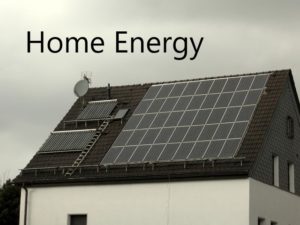
On this Page
- Condensing Boilers
- Heat Pumps
- Historic Buildings
Local Activities
Cost of Energy
For immediate help. contact Citizens Advice in Tadley, who have a specialist energy advisor. She will help you navigate the myriad of different schemes to provide assistance and help you access the right ones.
However, the best way to cut your fuel bills long term is to improve the energy efficiency of your home, and with energy bills rising, the payback on energy efficiency measures is getting better so it may be worth revisiting energy saving measures such as solar panels that you previously rejected.
With the recent rise in energy, every 1W of baseload (electrical items left on all the time) is now costing around £3 each year. We now have a plug in meter available to borrow, so you can find out what each individual appliance is actually costing you. We also have a clip on meter that acts like a smart meter that we can loan to residents. Contact Us if you would like to borrow the plug in electricity monitor or the clip on meter (or both!)
Advice on Energy Efficiency
Every home is different, so it is difficult to provide one size fits all advice. As a general rule, measures to cut energy usage (LED lightbulbs, stopping draughts, insulation, master switches and timers to turn off electrical devices when not in use) will pay for themselves very quickly. Fridges and freezers are some of the biggest users of electricity, so if you have more than one freezer, consider whether it is worth the £100+ per year it is costing you to run it. Solar panels with or without batteries will pay for themseives, but take longer. Heat pumps cut your carbon dioxide emissions a lot, and if you are not on mains gas can make financial sense too. There is a new calculator to work out if your home is suitable for a heat pump here. For more on heat pumps, see below.
These are a couple of good sources of home energy advice:
The Energy Saving Trust is a reliable source of information on possible energy saving measures and how much they might save you.
For personal advice, The Environment Centre in Southampton offers expert advice to individuals.
Energy Efficiency Loans & Grants
Basingstoke and Deane Borough Council have a range of loans and grants to help homeowners and landlords looking to improve energy efficiency.
If you are on means tested benefits or have a household income of less than £30,000 and live in a poorly performing house (an EPC rating of D, E. F or G) there are grants of up to £25,000 to pay the full cost of upgrading your home. These are also available if you rent your home, although your landlord may need to contribute. Applications are currently open aand the work needs to be completed by March 2023. Full details on www.warmerhomes.org.uk or call free on 0800 038 5737.
However, even if you don’t qualify for this grant, Basingstoke and Deane have a number of other measures to help you improve the energy performance of your home including low interest loans for up to £10,000. And for landlords, a grant of £500 to improve any tenanted property – well worth doing as the minimum EPC rating at which you can let your property is due to rise to a ‘C’ and possibly to a ‘B’ thereafter.
For details see BDBC Energy Efficiency Loans and Grants
Local Accredited Suppliers
If you are installing solar panels, heat pumps or other energy efficiency measures, it is important to have an MCS accredited or Trustmark accredited supplier. Click here for a list of local accredited suppliers.
Gov.uk also provides a guide to finding a heat pump installer, which is here
Group Purchase Schemes
Many suppliers will give a discount if several people order at the same time. If you are considering home improvements, why not contact Sustainable Silchester to see if anyone else is planning the same?
Your Home

Saving Money
Home energy use is probably the best way to save some money as well as cutting your carbon footprint.

How much carbon?
According to the Impact Community Carbon Calculator the average house in Silchester emits 6.47 tonnes of CO2 every year
Save up to 8% on your Gas Bill by adjusting your Condensing-Combi Boiler
A recent report by the Heating and Hot Water Council (HHIC) found that households can save around 6-8% on their gas bill just by turning down the flow temperature on their condensing combi boiler. To be clear, this is not turning down your thermostat.
What Does “Turning Down the Flow Temperature” Mean?
Most gas boilers are set up to deliver water at 80 degC, and return it to the boiler at 60 degC, having given off 20 degC to the room. This is called 80/60 flow. However these temperatures are too high for a condensing boiler to achieve the 92% efficiency that they are rated to. They only start condensing at 70/50 degC, and will only reach peak efficiency at 65/45degC or lower.
Won’t this make my house cold?
It does depend on the size of your radiators and how much energy you use to heat your home i.e. how well insulated it is.
For homes with modern double-glazing, cavity walls and good levels of loft insulation, you should be able to drop your flow temperature, with no impact on comfort. The radiators won’t get quite as hot, so if you are used to running your heating for short periods, you may need to run your heating for longer to maintain the temperature
The good news is that, it costs nothing to try it and see. Try turning down your flow temperature and testing to see if your house stays warm.
What kind of boiler do I need?
This tip is only suitable for homes fitted with a combi boiler (that is one that delivers hot water on demand without a hot water tank) installed withing the last 15 years.
Safety Warning If you have a hot water tank, then you need to run at higher temperatures to prevent legionella outbreaks in your hot water tank, so this tip is not suitable for you.
How do I reduce the flow temperature?
Most combi boilers have two dials on the front: one for heating (usually with a little radiator icon over it) and one for hot water (with a little tap icon). Some boilers have a digital display next to the dial, some have an up and down button, some just have vague markings so it is not actually possible to know what temperature you have lowered it to. Turn the dial down and see how you get on.
Here’s a short video on how to do it: Turn Down the Boiler Flow Temperature
The above is a summary of an article published by The Heating Hub
Heat Pumps
What is a Heat Pump?
A heat pump works like a refrigerator in reverse, taking heat from the surrounding air (air source heat pump) or ground (ground source heat pump) and converting it to heat to heat your building. For every kWh of electricity that you put in, it leverages the energy in the air or ground to give you more heat out. Exactly how much depends on the temperature outside, and the temperature that you want to deliver the heat, so it varies through the year between about a factor 2 and 5. Since the ground temperature is much more stable than the air temperature, a ground source heat pump is more efficient.
How much CO2 could I save?
It will vary by house and depending on the type of heat pump. For an air source heat pump in a house in Dukes Ride, I worked out that it would cut CO2 emissions from the current 4 tons per year to 1.65 tons per year. A saving of 2.35 tCO2/year.
How Much Does it Cost?
There is a government grant, the boiler upgrade scheme, which refunds some of your upfront costs – about £5,000 for an airsource heat pump on a house on mains gas, more for ground source heat pumps. The installation cost is likely to be £10 – 20, 000 for an airsource heat pump and £20 – £30,000 for a ground source heatpump.
If you have oil-fired heating, it should also significantly cut your energy bills and probably save you money over a 10-15 year time frame. If you have gas fired central heating the payback is likely to be longer.
For a lot more detail, have a look at the Energy Saving Trust website
What else do I need to know?
Have a read of our blog about one residents experience of replacing their gas boiler with an air source heat pump.
Because heat pumps are more efficient delivering heat at a lower temperature, you leave the heating on all the time to maintain a constant temperature through your home. You may also need bigger radiators or underfloor heating to transmit the heat.
An air source heat pump looks, and sounds, a bit like an air-conditioning unit outside your house. You may need planning permission, and almost certainly will if you live in a listed building or a conservation area. Having said that, heat pumps may be a particularly good solution for historic buildings because they deliver steady heat at a lower temperature rather than cycling heating and cooling.
If you do go for underfloor heating, it’s a relatively small addition to also make the heat pump cool your house in the summer.
To find out if your home is suitable for a heat pump, try the heat pump calculator
Historic Buildings and Conservation Areas
What do I need to Consider?
Historic buildings present different challenges for energy efficiency. You will almost certainly need planning permission for most changes and some (such as solar panels) are unlikely to be approved. For more on BDBC’s approach to sustainability in historic buildings see our blog on Historic Buildings and Planning.
Where should I go for advice?
The Sustainable Traditional Buildings Alliance has a lot of information about measures that you might consider see STBA Knowledge Centre . The Knowledge Wheel is a particularly good resource.
What could I do?
- Low energy lightbulbs
- Low energy appliances
- Keep in good state of repair and stop draughts
- Where possible, repair rather than replace
- Insulate loft, using a breathable form of insulation
- Consider secondary glazing
- Consider a heat pump